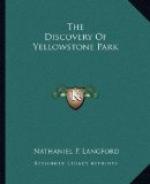This Northern overland route of over 1,600 miles, lay for most of the distance through a partially explored region, filled with numerous bands of the hostile Sioux Indians. It was the year of the Sioux Indian massacre in Minnesota. After a continuous journey of upwards of eighteen weeks we reached Grasshopper creek near the head of the Missouri on the 23d day of October, with our supply of provisions nearly exhausted, and with cattle sore-footed and too much worn out to continue the journey. There we camped for the winter in the midst of the wilderness, 400 miles from the nearest settlement or postoffice, from which we were separated by a region of mountainous country, rendered nearly impassable in the winter by deep snows, and beset for the entire distance by hostile Indians. Disheartening as the prospect was, we felt that it would not do to give way to discouragement. A few venturesome prospectors from the west side of the Rocky Mountains had found gold in small quantities on the bars bordering the stream, and a few traders had followed in their wake with a limited supply of the bare necessaries of life, risking the dangers of Indian attack by the way to obtain large profits as a rightful reward for their temerity. Flour was worth 75 cents per pound in greenbacks, and prices of other commodities were in like proportion, and the placer unpromising; and many of the unemployed started out, some on foot, and some bestride their worn-out animals, into the bleak mountain wilderness, in search of gold. With the certainty of death in its most horrid form if they fell into the hands of a band of prowling Blackfeet Indians, and the thought uppermost in their minds that they could scarcely escape freezing, surely the hope which sustained this little band of wanderers lacked none of those grand elements which sustained the early settlers of our country in their days of disaster and suffering. Men who cavil with Providence and attribute to luck or chance or accident the escape from massacre and starvation of a company of destitute men, under circumstances like these, are either wanting in gratitude or have never been overtaken by calamity. My recollection of those gloomy days is all the more vivid because I was among the indigent ones.
This region was then the rendezvous of the Bannack Indians, and we named the settlement “Bannack,” not the Scotch name “Bannock,” now often given to it.
Montana was organized as a territory on the 26th day of May, 1864, and I continued to reside in that territory until the year 1876, being engaged chiefly in official business of a character which made it necessary, from time to time, for me to visit all portions of the territory. It is a beautiful country. Nature displays her wonders there upon the most magnificent scale. Lofty ranges of mountains, broad and fertile valleys, streams broken into torrents are the scenery of every-day life. These are rendered enjoyable by clear skies, pure atmosphere and invigorating climate.




